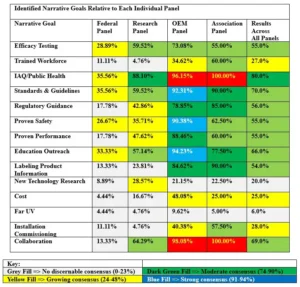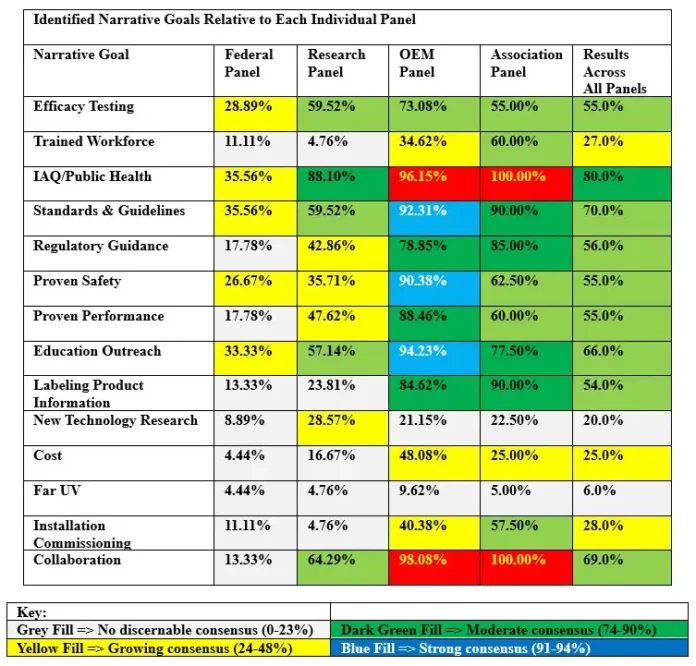By Michael T. Postek, The University of South Florida; and Troy Cowan, IUVA Healthcare/UV Working Group facilitator, [email protected]
This presents a high-level preliminary observational analysis of the data obtained from 2022 IUVA Americas Conference in Cincinnati, Ohio. It compares and contrasts the most important issues and goals between four stakeholder groups. The purpose of this paper is to synthesize this information and then distill and prioritize it into a primary set of issues and goals as input for IUVA’s June Roadmapping workshop on “Achieving Consensus on Germicidal Ultraviolet (GUV) in Public Spaces,” described below.
Introduction
Last September, IUVA staged its 2022 IUVA Americas Conference, addressing developments and issues of efficiency, performance and safety of UV applications for water, air, surfaces and food. During the event, the IUVA Healthcare Task Force led an interactive discussion on the latest trends in germicidal ultraviolet (GUV) technologies for healthcare. The discussions featured representatives from the federal government, NGOs, academia and industry, with updates on infectious diseases and a dialogue on GUVI in the context of looking ahead to the next 10 years. ¹
The panelists were asked to provide their comments on two questions for GUV technologies: Where are we? and Where are we going in the next 10 years? In response, four panels with a total of 21 panelists presented more than 170 narrative goals and issues. ² These goals and issues then were cross-walked into 14 broad categories (Table 1) for further development at the follow-up roadmapping workshop, “Achieving Consensus on Germicidal Ultraviolet (GUV) in Public Spaces,” in June.
Methods

The narrative contributions and slides from all 21 speakers were analyzed, and any technically pertinent issues and/or goals presented were logged. More than 170 narrative entries were analyzed and categorized into 14 overarching issues and goals, as seen in the first column of Table 1.
The tabular data points were analyzed, compared and contrasted between the 14 categories among each group of speakers to determine the most important topics between stakeholders’ groups. Results of the analysis are summarized in Table 2, where the percentages denote the degree of implied consensus amongst the panelists that these categories are important.
The frequency of these data demonstrated by the 14 issues and goals is presented in this work to induce intergroup dialogue for the upcoming Atlanta Workshop and in the industry as a whole. The main goal is to synthesize these issues and determine potential solutions for identifying an achievable subset. Ultimately, the groups will converge into an understanding of the state of the technology, what can be done to improve its acceptance and how to get a more consistent consensus of categories of immediate interest – which will lead to the determination of a plan to attack them.
The Panels
Federal Panel. This panel was designed to help provide insights into what the Federal Government Agencies see as the primary challenges over the next 10 years and how they would consider working with industry to help in their mitigation. The Panel consisted of seven representatives of the federal government from the following organizations: White House Office of Scientific Programs (WH-OSTP), Pacific Northwest National Laboratory (PNNL), US Department of Energy, Food and Drug Administration (FDA), National Institute for Occupational Safety and Health (CDC/NIOSH), National Institute of Standards and Technology (NIST), Occupational Safety and Health Administration (OSHA) and Environmental Protection Agency (EPA). While these panelists were not empowered to present or define governmental policies, their insights were used to get an understanding of agency priorities and direction regarding the topic of GUV.
Panel 1: Research & Development Infectious Disease Experts. This panel of four research scientists, experts in the infectious disease world, presented their insights on the latest biological threats and their thoughts for looking ahead. Represented in this panel were senior scientists from a major Federal medical center, and the schools of medicine, environmental engineering and public health from three prestigious US universities.
Panel 2: Original Equipment Manufacturer (OEM) panelists from GUV Product Suppliers/SMEs. In this panel, five senior OEM representatives, including three CEOs and two senior vice presidents, described where and how their products are being used currently and what pressing challenges are being faced in adoption of their technologies. The panelists also were invited to comment on what they saw as industry trends in adapting to the new situations predicted in the previous panel.
Panel 3: GUVI-Related Industry Associations. The panel included seven representatives from major industry associations involved in GUV technologies and applications. They included International Ultraviolet Association (IUVA); Institute of Education Sciences (IES); American Society of Heating, Refrigerating and Air-Conditioning Engineers (ASHRAE); National Electrical Manufacturers Association (NEMA); International Electrotechnical Commission (IEC); International Organization for Standardization (ISO-TC/142) and the Global Lighting Association (GLA). These associations and organizations described where they and their members are going and what they see as industry trends in adapting to the new situations predicted in the previous sessions.
Results
An effort was made to determine the level of “consensus,” or relative agreement, between the panelists on the importance of a given category. To do this, the number of identified narrative goals relative to each individual panel was calculated as a percentage of the total number of narratives obtained. This is shown in Table 1. In this case, the higher the percentage, the higher the four panels’ level of consensus was demonstrated in the particular issue or goal. Colors were assigned to those with no discernable consensus (grey), perceived growing consensus (yellow), mild consensus (light green), strong consensus (blue) and overwhelming consensus (red).
Analysis
Some of the findings that can be derived from these data are as follows:
- The highest-rated goal in all panels was public health.
- There is strong consensus regarding collaboration, and it is of great interest to the majority of the panels.
- Although cost is cited as an important factor in at least one of the presentations, there is little consensus overall that this is an important issue.
- There seems to be little consensus for new technology research as an issue.
- Comparison of the Government panel’s consensus to the other three panels is generally low. That is expected since the government mission space is quite broad. Depending upon the agency involved, each has specified mission space to assist or regulate US business once the need has been identified. This also is reflected in the lower number of goals logged in comparison to the other panels.
- Concerns regarding a trained workforce had a low consensus of interest, although the interest was understandably higher for the OEMs and associations.
References
- IUVA Americas 2022 Agenda for Weds. September 28, 2022 https://iuva.org/2022-IUVA-AC-Wednesday.
- IUVA Americas 2022 Panelists’ Presentations from Weds. September 28, 2022, https://iuva.org/resources/2022%20Americas%20Conference/Proceedings/Wednesday%20Session%20Panelists%20Slides%20Combined.pdf.





